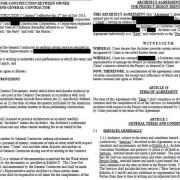Low Bid Contracts: Be Careful What You Ask For
In an earlier post, we talked about some of the pitfalls of low-bid-only procurement processes, including points like the absence of a relationship between low-bid and total cost. This time I’m going to share more, equally important, pitfalls of the low-bid only process.
The low-bid-only process significantly increases the client’s exposure to risk. The three types of risk we discussed previously are:
• Low profit margins
• Diminishing professional expertise
• Bankruptcy
However, there are even more major areas of risk…
Performance
The low bid-only process rarely addresses performance–and what is a low price without performance?
In fact, a low bid environment invites a mismatch between the client’s expectations and the vendor’s performance. It works like this: Knowingly or unknowingly, clients issue a RFP containing their specifications. The type of vendor service doesn’t matter. It could be IT, relocation, engineering, construction or audiovisual. In every case the specifications, due to the emphasis on price, become minimum standards. Immediately a problem arises.
In all likelihood, the client assumes they are getting everything they need. In fact, by virtue of the low-bid process it’s just the opposite. The low bid-only standard demands that the vendor do no more than what is articulated in the specifications. The specifications then control everything. If the client missed something, they don’t get it–or at least not cost effectively.
Control
Once a vendor’s contract is signed, the relationship between the client and the vendor becomes a monopoly. This may not be true in every case, but it’s certainly a risk. According to Barry B. Lepatner in his book, Broken Buildings, Busted Budgets.
“Once awarded the contract, the contractor then changes…[f]rom the highly competitive world needed to secure the project …to that of a monopolist. As a monopolist, the contractor is in total control over the project: its cost, its schedule and the manner in which it is run. Typical owners often have no good option for recourse when faced with spiraling costs and delays.”
Change orders, by the way, are increasing in number. The U.S. construction industry spends up to $135 billion a year on change orders, or about 9-11% of total construction costs.
Attitude and Commitment
Some (but not all) vendors will deliberately submit a low bid as a loss-leader. The appeal of potential high-dollar future work is a powerful draw. Some vendors blend this into their proposal. For example, I had one client that sent out a RFP for a small project. However it was common knowledge that this client had a potentially large project coming up in the future. At least one bidder was banking on the likelihood of getting the follow-up work, despite the fact that future work was never suggested or promised by the client. Quite the contrary.
Once it became clear that the larger project was not to be an opportunity, attitude and commitment dramatically decreased– and at the worst possible time. Recall that once the contract is signed, especially with A&E and construction work, the vendor becomes a monopolist (see above).
Biggest Mistake Wins
There is an old, overused saying among bidders on public projects: The work isn’t awarded necessarily to the lowest bidder; it’s awarded to “the vendor that made the biggest mistake,”
I’m reminded of an anecdotal story about a well known construction firm in the Inland Empire. They had for a long time enjoyed a prominent, profitable position in the large scale industrial construction niche. I’m told that a simple math error was their undoing. A small estimating error on the cost-per- unit of widgets multiplied by 1 million widgets was their fatal flaw. Shortly after that came a flurry of subcontractor liens from unpaid subs and, presumably, bankruptcy.
Adversarial Relationship
The combination of a low bid process coupled with minimum specifications gets all the parties off on the wrong foot. Also, it predictably creates an adversarial relationship with the owner. The vendor naturally seeks to maintain a reasonable profit by adhering to the minimum (or maybe faulty) specifications. The owner, on the other hand, assumes they’re getting the full-meal-deal. The net result of these contradictory perspectives often times results in unnecessary conflict and heartburn. So where does that leave us?
Conclusion
Low Bid-Only Procurement is Risky and Wrong.
Let’s review.
• Low bid-only procurement is not empirically related to total overall cost
• Low bid only results in lower profit margins
• Lower profit margins are going to hurt someone: Either the client through change orders or the vendor in bankruptcy
• The low bid-only process sets up an adversarial relationship.
• While the nominal price may be minimized, so is vendor motivation to perform.
• Vendor estimating mistakes are not only given priority, they are “rewarded”.
What is the Right Answer?
What’s needed is an entirely different approach. One that empirically infuses the vendor selection process with other dimensions of performance besides the lowest price.
I’m not saying it’s easy, but I am saying it should be mandatory. The lowest bid is never the best value. Competitive bidding, as it is euphemistically known, isn’t the remedy because it fails to account for the total cost and quality of the job.
A Proven (and Provable) Approach is compelling and logical. However, it requires a unique skill set and training beyond what is typically required of the average PM.
If you don’t have a process guaranteed to filter for the best value, keep your checkbook handy.
Mr. Conzelman is a licensed electrical contractor and general contractor, LEED® AP, PMP, CCM, and a California RE Broker License 01128636. Mr. Conzelman graduated from Western State University, College of Law and has taught Contracts-for-Contractors. Tom Conzelman is the author of “Protect Your Project”, the innovator behind the No Change Order Guarantee™ and the creator of the revolutionary Negatively Inferred Scope™ procurement process; Stopping Specification-Driven Change Orders and Rework.
Copyright 2014











